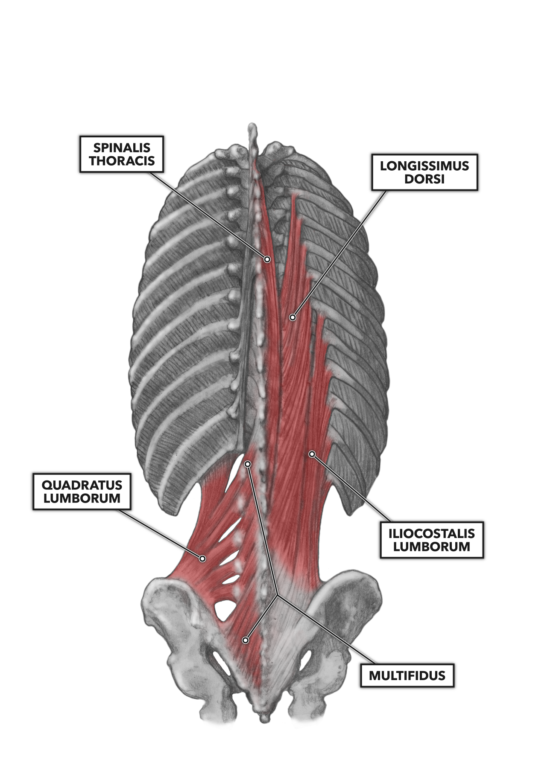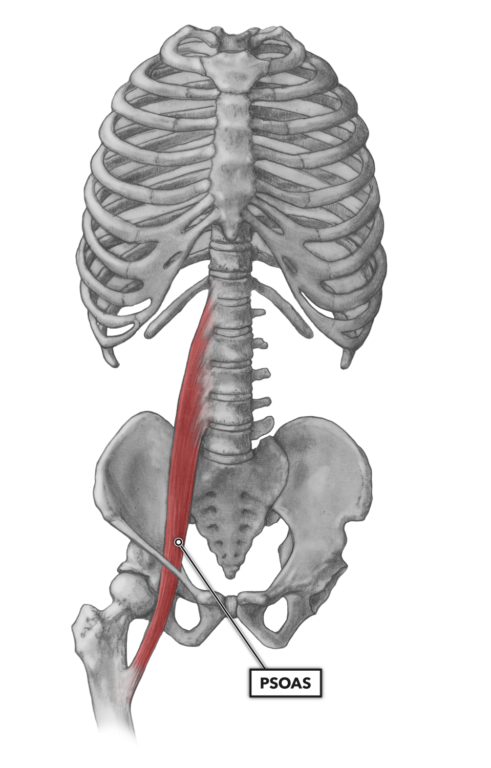As with musculature in other segments of the vertebral column, the lumbar muscles (Figure 1) have attachments in the segments above and below. These muscles contribute to respiration, posture, and the mobility of the vertebral column.

Figure 1: Lumbar musculature
Longissimus dorsi – “Longissimus dorsi” is often used to refer to several associated muscles: the longissimus capitis, longissimus cervicis, longissimus thoracis, and longissimus lumborum. Another term associated with these muscles is “erectors spinae,” or “spinal erectors,” which names the functional grouping to which they belong. Together, these closely integrated longissimus muscles span the majority of the back, having robust attachments along the length of the entire axial skeleton. Specifically in the lumbar segment, this multi-segment muscle attaches to the lower ribs, then angles down medially to attach to the transverse processes of the lumbar vertebrae. The lowest tendon slips merge with the lumbodorsal fascia that covers and attaches to the sacrum.
The upper segments attached to the ribs and thoracic vertebra function primarily to pull the posterior aspect of the ribs down toward their lower attachments on the lower thoracic and upper lumbar vertebrae. This function contributes to respiration and posture. Unilateral contraction aids in lateral flexion.
Iliocostalis lumborum – Like the longissimus dorsi, this muscle is part of an integrated set; it includes the iliocostalis cervicis, iliocostalis thoracis, and iliocostalis lumborum. This muscle set is also considered part of the functional grouping, erectors spinae. The most superior segments of the iliocostalis lumborum attach to the posterior and inferior surfaces of the ribs. The iliocostalis lumborum then runs downward, alongside the longissimus, and its lower tendons attach to the medial iliac surface, fuse with the sacroiliac ligament and lumbodorsal fascia, terminating along the medial sacral crest.
The muscle can pull the thoracic ribs down, extend the lower thoracic and lumbar vertebral segments, and contribute to lateral flexion.
Quadratus lumborum – The quadratus lumborum, at its lowest point, attaches along the inner surface of the iliac crest. From this connection, the muscle fans upwards, attaches to the transverse processes of the lumbar vertebrae, and at its most superior aspect, attaches to the medial half of the 12th rib.
As the muscle attaches to the lowest rib (12th) from below, bilateral contraction can stabilize the rib and allow superior muscles to pull the ribs down. It can also contribute to lumbar vertebral extension with bilateral contraction and lateral flexion with unilateral contraction. The muscle also has functions at the hip.
Multifidus – As with the cervical and thoracic segments, the multifidus is found deep, crossing three vertebrae (or four) from medial to lateral along the length of the vertebral column. They attach to the spinous process of a higher vertebra and to the transverse process of a lower vertebra. The muscle group terminates with attachments to the sacrum. As the size of the individual vertebrae increases — cervical, thoracic, lumbar — so does the size of the multifidus. As these muscles are primarily stabilizers of the vertebral column, the longer the vertebral segment requiring stabilization, the larger a muscle required.

Figure 2: The psoas
Psoas (Figure 2) – This is a long muscle that has its most superior attachment to the last thoracic vertebra. It then attaches to the transverse processes of the five lumbar vertebrae before angling downward and laterally to terminate in attachment at the lesser trochanter of the proximal femur.
Actions at the lumbar are lateral flexion with unilateral contraction, rotation with asymmetric contraction, and forward flexion of the lumbar vertebrae with bilateral contraction. The psoas has other actions at the hip.